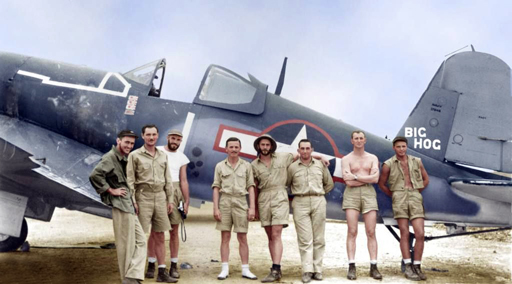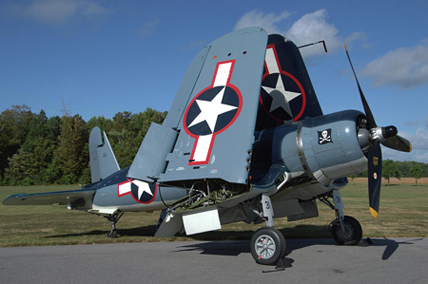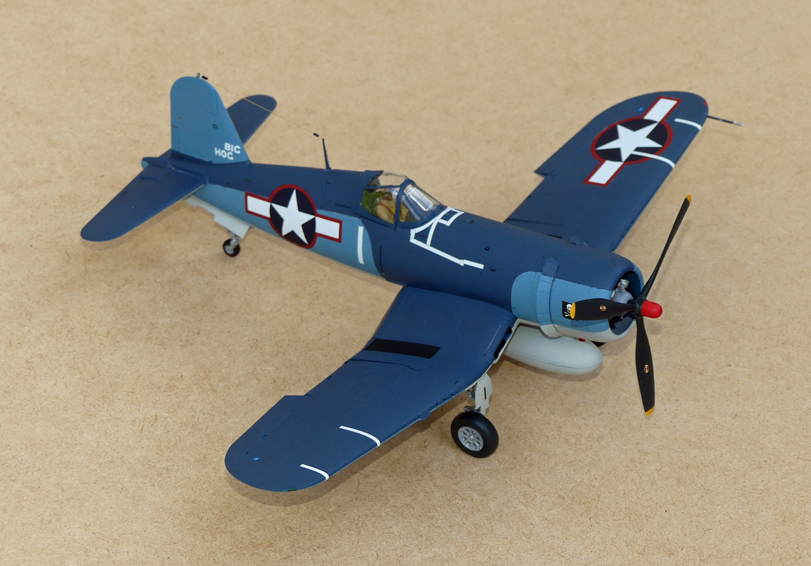 <>
<>
 <>
<>
The F4U Corsair is an American fighter aircraft that saw service primarily in World War II and the Korean War. Designed and initially manufactured by Chance Vought, the Corsair was soon in great demand; additional production contracts were given to Goodyear, whose Corsairs were designated FG, and Brewster, designated F3A.
The Corsair was designed and operated as a carrier-based aircraft, and entered service in large numbers with the U.S. Navy in late 1944 and early 1945. It quickly became one of the most capable carrier-based fighter-bombers of World War II. Some Japanese pilots regarded it as the most formidable American fighter of World War II, and its naval aviators achieved an 11:1 kill ratio. Yet early problems with carrier landings and logistics allowed it to be eclipsed as the dominant carrier-based fighter by the Grumman F6F Hellcat, powered by the same Double Wasp engine first flown on the Corsair's first prototype in 1940. Instead, the Corsair's early deployment was to land-based squadrons of the U.S. Marines and U.S. Navy.
The Corsair served almost exclusively as a fighter-bomber throughout the Korean War and during the French colonial wars in Indochina and Algeria. In addition to its use by the U.S. and British, the Corsair was also used by the Royal New Zealand Air Force, French Naval Aviation, and other air forces until the 1960s.
From the first prototype delivery to the U.S. Navy in 1940, to final delivery in 1953 to the French, 12,571 F4U Corsairs were manufactured in 16 separate models. Its 1942–53 production run was the longest of any U.S. piston-engined fighter.
Corsairs were flown by the "Black Sheep" Squadron (VMF-214, led by Marine Major Gregory "Pappy" Boyington) in an area of the Solomon Islands called "The Slot". Boyington was credited with 22 kills in F4Us (of 28 total, including six in an AVG “Flying Tigers” P-40, although his score with the AVG has been disputed).
In January 1944, Boyington, outnumbered by Japanese "Zero" planes, was shot down over the Pacific Ocean after downing one of the enemy planes. He was captured by a Japanese submarine crew and was held as a prisoner of war for more than a year and a half. He was awarded the Purple Heart, Navy Cross and Medal of Honor.
One particularly unusual kill was scored by Marine Lieutenant R. R. Klingman of VMF-312 (the "Checkerboards") over Okinawa. Klingman was in pursuit of a Japanese twin-engine aircraft at high altitude when his guns jammed due to the gun lubrication thickening from the extreme cold. He flew up and chopped off the enemy's tail with the big propeller of the Corsair. Despite missing five inches (127 mm) off the end of his propeller blades, he managed to land safely after this aerial ramming attack. He was awarded the Navy Cross.
Facts and General Characteristics of the Vought F4U-1A Corsair:
Contractor: Chance-Vought Facts and General Characteristics of the Model: The model represents No. 1 “Big Hog”, U.S. Navy VF-17 (The Jolly Rogers) based at Ondonga Airfield, New Georgia in the Solomon Islands, November 1843.
Manufacturer: Tamiya, INC., Japan (made in Philippines)
Type: Fighter
Crew: 1
Wingspan: 41 ft. (12.5 m)
Height: 14 ft. 9 in. (4.5 m)
Length: 33 ft. 8 in. (10.26 m)
Weight: Empty 9,205 lbs. (4,238 kg), max takeoff 14,533 lbs. (6,592 kg)
Powerplant: Pratt & Whitney R-2800-8W Double Wasp, 18-cylinder, air-cooled radial engine, 2,000 hp (1,491 kW)
Maximum speed: 446 mph (718 km/h)
Range: 1,005 mi (1,617 km), with drop tank: 1,500 miles (2,400 km)
Service ceiling: 36,900 ft. (11,247 m)
Armament: 6 x 12.7 mm M2 Browning machine guns, wing-mounted
Scale: 1/48
Wingspan: 10 in.
Length: 8.25 in.
Height: 2.75 in.
Parts: 90
Decals: 57
Hours to build and paint: 27.6







